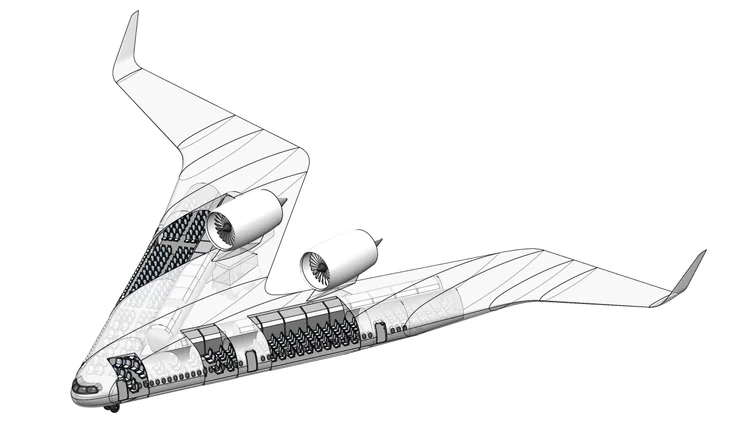Play below for the audio version of this article:
The designs of the most efficient and least polluting aircraft most ready to come true are all based on the classic structure in which passengers are housed in the fuselage and the wings support the engines and contain the fuel. But there are also ideas, some in an advanced stage of development, which propose more or less profound variations to this classic scheme, with the aim of obtaining aerodynamic advantages, lower fuel consumption and higher ranges. The most curious project is perhaps that of the “Flying V” or Flying V which was born from an idea of almost ten years ago formulated by Justus Benad, at the time a student of the Technical University of Berlin who was doing an internship at Airbus . Benad had conceived an aircraft without a fuselage, with large, very pronounced V-shaped wings in which passengers would fit. The concept immediately showed interesting potential and was developed into a prototype by the Dutch University of Delft, where Benad had meanwhile moved. «The flying V», explains its creator, «was born to create an airplane similar in capacity to the Airbus A350, of which it replicates the number of passengers, 314, and the wing width of 65 meters».
The height is also similar, in order to use the same airport facilities suitable for other airliners. But overall the aircraft is much shorter, has less mass and offers less air resistance than the A350, with much lower fuel consumption to cover the same distances. The first test flights of 2014 proved to be very promising, to the point that the Faculty of Aerospace Engineering of the University of Delft decided to start a project for the development of the flying V, entrusted to Roelof Vos, professor of engines and performance of fly. A revised version was born that is believed to reduce fuel consumption by 20% compared to a traditional aircraft. In October 2020, a scale model, 3 m long and 22.5 kg heavy, successfully completed its first flight. The designers envision two versions, one with traditional fuel and one with hydrogen, which would have a 35% lower range but would be totally zero emissions.
In this work, an idea for a commercial passenger aircraft was derived. Preliminary estimations indicate potential benefits of the new concept called the “Flying V” over the A350-900 reference aircraft: 10% higher L/D, 2% lower mass, a compact and simple configuration (no high-lift devices, no fairings, straight lines), and low noise (shielding of the engines from the ground).

A streamwise cut through the oblique pressurized section of the Flying V is flat and elliptical and thus it fits efficiently into airfoils. This leads to both structural and aerodynamic efficiency. A patent application for the concept was filed by Airbus [1].

Remarkable is also the elliptical lift distribution of the stable design using only moderate wing twist and no reflexed camber lines. A radio controlled model of the Flying V was built to demonstrate these aerodynamic characteristics and support estimations and simulations which were made in this work.
The first flight of the glider version of the demonstrator model took place in Berlin, Germany on February 28, 2014:

The first flight of the powered version of the demonstrator model was in Hamburg, Germany on April 13, 2014:

The pilot of the first powered flight was Simon Hinsch.
Presentation and flight videos:
For a full length video presentation with more details on the Flying V design see this news post from February 4, 2015.
The video highlights, including flight videos of the first demonstrator, can be watched in this video:
Flying V, Presentation at TU Berlin from Justus Benad on Vimeo.
